
Organizing Food at Sea Menu: 1 2 3 4 5 6 7 8 9 10 11 12 13 14 15 16 17 18 Next>>
Organization of Ship's Food In the Golden Age of Piracy, Page 16
Golden Age Pirate Quartermasters - Overseeing Captured Ship Boarding
In discussing the role of the quartermaster in his book, Charles Johnson wrote that the quartermaster
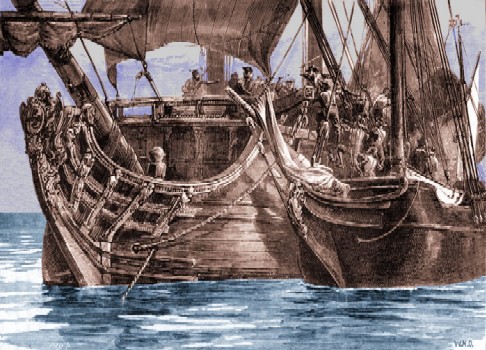
Pirates Boarding a Ship, From The Sea - Its Stirring Story of Adventure, Peril, & Heroism.
Vol. 3,
By Frederick Whymper (1878)
"is the first on board any Prize [ship]"1. None of the other books under study specifically mention the QM being first, however, and Johnson's book is best cross-checked with other period sources to verify such direct statements on pirate behavior. Several accounts do support the idea that the quartermaster would be a part of the boarding party when a ship was taken. Speaking at the trail of Bartholomew Roberts men, witnesses Harry Glasby and Robert Lilburn testified that upon boarding a ship, "after the Quarter-master has done with taking what he thinks fit for the Company's use, those that go with him do then serve themselves".2 The fact that Roberts' quartermaster was required to be on board a prize ship to determine what supplies their crew might need (such as food, ship's supplies and the like), indicates he would have to be aboard once a ship was captured. William Magness, one of Robert's quartermasters, testified that "his Place of Quarter-Master... obliged him to go on Board what they call Prizes"3. It does not say he had to be among the first to board, however.
There are a number of accounts which mention the quartermaster being aboard a prize,
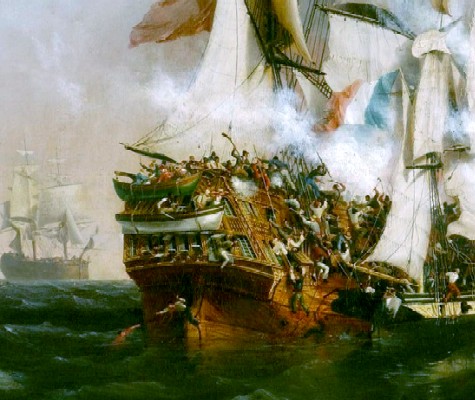
Artist: Ambroise Louis Garenray - Men Boarding a Ship, Capture of the Kent (1836)
giving orders to other pirates along with similar indications that the quartermaster was aboard a prize and in charge. In Charles Johnson's account of the trial of William Fernon, a member of Bartholomew Roberts' crew, Fernon says, "Roberts commanded us into the Boat [which was rowed over to the captured ship], and [along with] the QuarterMaster to rob the Ship [the Elizabeth]; neither of whose Commands we dared to have refused."4 Here, the captain chose the men to board a prize while the quartermaster took charge of them once they were aboard. However, in the actual trial account, it is mentioned that Fernon "was order'd by the Quarter-master in her [the Elizabeth]"5. The second account is more likely correct.
The quartermaster was clearly in charge of the boarding party when William Snelgrave's vessel Bird was taken by pirates Jeremiah Cocklyn, Olivier Lavasseur and Howell Davis off the coast of Africa in 1719. His ship was boarded by one of their quartermasters, who "ordered the Pirates to tie our People's Hands ...and told me, 'My Life was safe provided none of my People complained against me.'"6
1 Daniel Defoe (Captain Charles Johnson), A General History of the Pyrates, Manuel Schonhorn, ed., 1999, p. 213; 2 "The Tryals of the Pyrates Lately Taken by His Britannick Majesty's Ship the Swallow", British Piracy in the Golden Age, Volume 3, Joel Baer, ed., 2007, p. 117; 3 "The Tryals of the Pyrates Lately Taken...", p. 94; 4 Defoe (Johnson), p. 262; 5 "The Tryals of the Pyrates Lately Taken...", p. 124; 6 William Snelgrave, A New Account of Some Parts of Guinea, 1734 p. 208
Golden Age Pirate Quartermasters - Holding and Dividing Spoils
Several pirate crew articles support the quartermaster's role in keeping and dividing the wealth which their pirates managed to
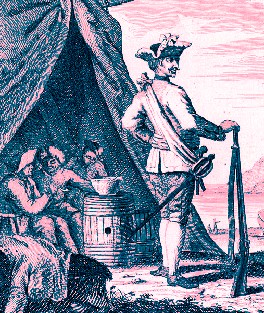
Artist: Joseph Nicholls
Captain George Lowther and His Company (1736)
take from their conquests. One of John (Richard) Taylor's articles read, "All plunder taken from a prize must be handed over to the quartermaster, on pain of a flogging and forfeiture of all possessions to the good of the company. "1 Such plunder given to the quartermaster would be held it in common until it was time for the spoils to be divided. Pirate George Lowther's fourth article said, "If any Gold, Jewels, Silver, &c. be found on Board of any Prize or Prizes, to the Value of a Piece of Eight, and the Finder do not deliver it to the Quarter-Master in the space of 24 hours [he] shall suffer what Punishment the Captain and the Majority of the Company shall think fit."2 This article is a little more specific than Taylor's, being concerned only with money, precious metals or jewels. Edward Low, who sailed in consort with Lowther for quite some time, had a nearly identical article.3 Thomas Anstis' third article, while similar to the others, is even more particular: "If any p[er]son or p[er]sons should go on board of any Prize and should break open any Chest without the knowledge of the Quarter Master [he] shall suffer what punishment the Company and Capt. shall think fit."4 Here the concern seems more to be over someone concealing small, precious items such as coins and jewels.
The common thread in all of these pirate articles is the quartermaster, who was charged with evaluating the wealth of a prize and keeping track of those items which provided the most portable wealth. As mentioned, the quartermaster had to be one of the first men aboard a captured prize ship, in part so he could decide what was to be kept for the common good and what returned to the prize ship's owners, "excepting Gold and Silver, which they have voted not returnable."5
According to pilot Jacob du Bucquoy,
\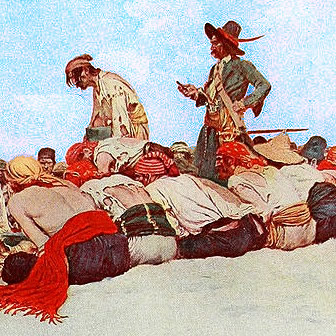
Artist: Howard Pyle - So the Treasure Was Divided (1906)
who was aboard John (Richard) Taylor's Cassandra, the Quartermaster was "the custodian and distributor of booty" on their ship.6 He adds, "When they have finished a cruise, they usually come to recuperate at Madagascar, where they divide of spoils which they dissipate in no time. This division is made by the quarter-master, overseen by four crew members."7 Navy sailor Clement Downing said that John Plantain, another Madagascar-based pirate, asserted that when John Williams' pirates captured a ship called the Prosperous that contained "a considerable number of East-Indian Bales, which they hoisted up on Deck, and cut open; the Quarter-master distributing the same amongst the Pyrates."8
On some ships, the crew could also request some of their share of the loot on an 'as needed' basis. Sailor Thomas Baker deposed that after pirate Samuel Bellamy had taken a rich prize, the "Quarter Master declared to the Company, that if any Man wanted Money he might have it."9 During the court trials of Edward Low's men, such individual disbursements to sailors were mentioned in testimony. John Brown said "that the Quarter-Master gave him about Forty Shillings". Similarly, William Jones received nineteen pounds from the quartermaster, while Charles Church declared that he "never shared [any of the treasure taken], but the Quarter-Master gave him about Fourteen Pounds."10 Church's statement suggests that because he wasn't there for a division of the bulk of money captured, he felt he should not be considered as guilty for taking only a small sum. If this was the intent, it did not succeed.
The other part of the quartermaster's job in regard to treasure was holding it until it could be divided up properly, something mentioned in the several articles cited above. At the John Quelch's trial, Matthew Pymer testified that "the Quarter-master had the Money that was taken out of her [the prize brigantine Charles], being some Coyned Gold and some Silver", which totalled
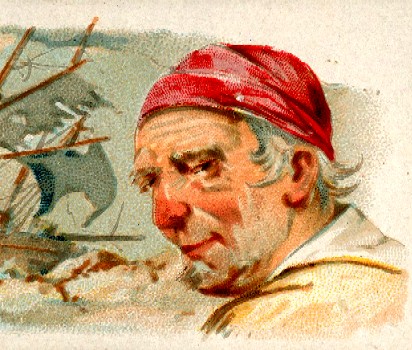
A Fanciful Illustration of Samuel Bellamy and the Whydah, Allen & Giunter Cigarette
Cards, Pirates of the Spanish Main Series (c. 1888)
about 50 pounds.11 When pirates Samuel Bellamy and Olivier Levasseur were sailing together, Peter Cornelius Hoof reported, "Their Money was kept in Chests between Decks without any guard, but none was to take any without the Quarter Masters leave."12 According to du Bucqoy, after Taylor's crew had captured a Portuguese vessel, they, "opened the chests and cases with levers, and delivered to the quartermaster all they contained of diamonds, and of gold or silver, either coined or in bars."13
The quartermaster apparently was given total power over the wealth of the company, at least according to one source. When the pirate consortium of Howell Davis, Olivier Levasseur and Jeremiah Cocklyn were going ashore at Africa, they decided to wear some embroidered coats found in prisoner William Snelgrave's chest to impress the women there. However, Snelgrave notes that they took "these Cloaths without leave from the Quartermaster, [and] it gave great Offence to all the Crew; who alleg'd, 'If they suffered such things, the Captains would for the future assume Power, to take whatever they liked for themselves.' So upon their returning on board the next Morning, the Coats were taken from them, and put into the common Chest, to be sold at the Mast."14
1 Ed Fox, "Piratical Schemes and Contracts," Thesis, 2013, p. 315; 2 Fox, "Piratical Schemes and Contracts,", p. 321; 3 "Tryals of Thirty-Six Persons for Pyracy", British Piracy in the Golden Age, Volume 3, Joel Baer, ed., 2007, p. 191; 4 Fox, "Piratical Schemes and Contracts,", p. 319; 5 Daniel Defoe (Captain Charles Johnson), A General History of the Pyrates, Manuel Schonhorn, ed., 1999, p. 213; 6 "Jacob du Bucquoy describes life in the company of John Taylor", Pirates In Their Own Words, Ed Fox, ed., 2014, p. 287; 7 "Jacob du Bucquoy...", p. 289; 8 Clement Downing, A Compendious History of the Indian Wars, 1737, p. 108; 9 Cited in Baylus Brooks, "Baker, Thomas", Dictionary of Pyrate Biography, 2020, p. 26; 10 "Tryals of Thirty-Six Persons for Pyracy", British Piracy in the Golden Age, Volume 3, Joel Baer, ed., 2007, p. 181-2; 11 "The Arraignment, Tryal and Condemnation of Capt. John Quelch", British Piracy in the Golden Age, Volume 2, Joel Baer, ed., 2007, p. 273; 12 Peter Cornelius Hoof, cited in "Hoof, Peter Cornelius", Dictionary of Pyrate Biography, Baylus Brooks ed., 2020, p. 216; 13 Jacob du Bucquoy, Baylus Brooks, translator, 2018, p. 21; William Snelgrave, A New Account of Some Parts of Guinea, 1734, p. 257
Golden Age Pirate Quartermasters - Managing and Distributing Food and Ship Supplies
A pirate quartermaster had a couple responsibilities when it came to food. First, he was to oversee its use and distribution and second, to attend to its procurement. Former pirate John Plantain told navy man Clement Downing that, although they couldn't be sure of having enough food on hand at all time, "every Man is allowed to eat what he pleases. Then they put all under the care of their Quarter-master, who discharges all things with an Equality to them all, every Man and Boy faring alike; and even their Captain, or any other Officer, is allowed no more than another Man."1 In support of this,
\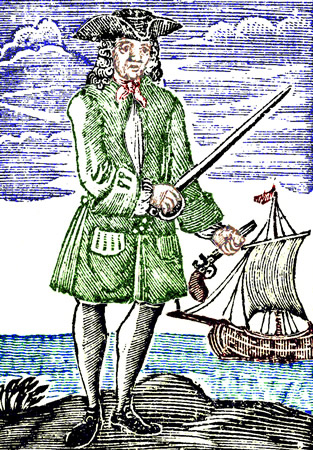
Francis Spriggs, Yet Another Image Drawn Without Any
Reference Material (1725)
Richard Hawkins, a captive of Francis Spriggs' crew, explained that "at Meals the Quarter-Master overlooks the Cook, to see the Provisions equally distributed to each Mess"2.
Many pirate quartermasters are also mentioned as the agents who procured victuals, either from prize ships or through purchase. There is quite a bit of evidence to support pirates legitimately purchasing food, although only one account specifically mentions the quartermaster's involvement. Upon reaching Kochi, India in the Speedy Return around 1703, John Bowen's crew fired their guns to indicate that they wanted food brought from the shore for them to purchase. When none appeared, George Weoly reported that quartermaster Nathaniel North "went near the Shoar, and had Conference by Boat with the People, who supplied them next Day with Hoggs, etc. Refreshments."3
There are a few instances of the quartermaster taking food, which makes sense given what we know about his responsibility for overseeing the procurement of supplies. During Bowen's voyage, they encountered a Dutch ship whose captain ordered Bowen and his quartermaster aboard to find out why they were there, fearing they might be pirates. Bowen and North replied that they "came in for Provision; [the Dutch captain] reply’d, they could get none there, and the best Way was to be gone; however the Quarter-Master went ashore (where the Dutch [man] had made his Factory [warehouse], and had some Goods) and shot down three Oxen, which he ordered the Natives to help to cut in Pieces"4.
Since the quartermaster was responsible for boarding prizes and deciding which supplies were needed
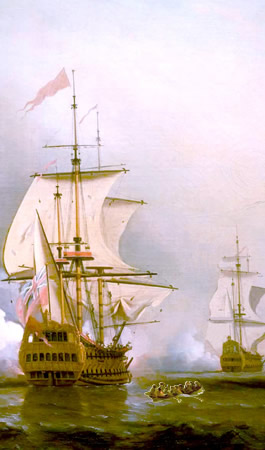
Artist: Samuel Scott
Boarding a Ship, Wager's Action off Cartagena (mid 18th)
'for the good of the crew', it should not be surprising that there are examples of this sort of theft. The master of the captured vessel Gertruyt deposed during the trial of Bartholomew Roberts' crew that quartermaster William Magness "came on Board as Quarter-Master of the Pyrates, and order'd his Provisions out"5. Captain John Frost told the Boston News-Herald that he was captured by Olivier Levasseur on July 4, 1717 and that "the Quarter Master of the Pirate and several others went on board Frost's Ship, broke open the Hatches, hoisted out and took an Hogshead of Rhum, one Hogshead and several Barrels of Sugar ...one of the Pumps...and sundry Stores."6 Parts of this account are vague enough that they could have taken provisions, although rum and sugar were two key ingredients for punch. So they were likely not food at all and 'stores' mentioned probably refer to things required to keep the ship running.
This brings us to ship's supplies, another thing pirate quartermasters were responsible for procuring, usually by theft from other ships. The above example mentions two pumps being taken from Frosts's ship which were used to empty water from the hold. (Water that washed over a ship during rough seas typically found its way to the hold, so there was pumping it out of the hold was a common requirement. If a leak occurred, the water collected much more rapidly requiring frequent, sometimes constant, pumping until the ship could be repaired. As noted, 'sundry Stores' almost certainly refers to things like lines, spars, sails, cannon, shot, gunpowder, ironwork and possibly even masts.
A variety of examples of Bartholomew Roberts' men stealing supplies for their ships are found in their trial at Cape Coarse Castle in 1722. Pirate William Petty testified that he took the sails out the prize ship King Solomon, "by the Quarter-master's Order first to him" when he boarded the ship.7 (Although it was common for sailors to blame their officers for pressuring them into the criminal acts they committed, this likely has a certain amount of truth behind it.) Pirate Abraham Cooper explained at his trial that he had examined coopers James Munjoy's tools aboard the prize ship Elizabeth because
\
Photo: Sean D. Langton - South End of the Isle of May in the Firth of Fourth
"he was obliged to look [to see if the pirate ship had use for any of these tools] by the Quarter-master's Order, but took none away"8. (Prisoner Munjoy had earlier testified that Cooper had 'over-haled' his tub of tools, after which he never saw them again.) The Boatswain of the Carlton which Roberts' crew had captured said that pirate Cuthbert Goss "was there by Order of the Quarter-Master, examining the Arms Chest, taking Arms out of it, and held a Cutlass in his Hand."9
The pirates didn't always just steal supplies outright... or at least they sometimes pretended that they didn't. At the beginning of Henry Every's career in 1694, he was at the Isle of May where they captured three English vessels. "[O]ne of the quartermasters, probably Henry Adams, gave the masters of the three English ships 'bills' for the supplies that had been taken from them."10 This at least gave things the appearance of propriety, although the question of how the owners of these ships might go about collecting on such chits is something to be wondered at.
1 Clement Downing, A Compendious History of the Indian Wars, 1737, p. 108; 2 '59. Richard Hawkins’ account of his capture by Francis Spriggs, The British Journal, 8 August, 1724 and 22 August, 1724.', Pirates In Their Own Words, Ed Fox, ed., 2014, p. 301; 3 "51. George Weoley, George Weoley to Mr Pennyng, 7 November 1703. Printed in The Case of Captain Thomas Green (London, 1705), pp. 18-21", Pirates In Their Own Words, 2014, Ed Fox, ed., p. 263, See also Daniel Defoe (Captain Charles Johnson), A General History of the Pyrates, Manuel Schonhorn, ed., 1999, p. 462; 4 Defoe (Johnson), p. 493; 5 "The Tryals of the Pyrates Lately Taken by His Britannick Majesty's Ship the Swallow", British Piracy in the Golden Age, Volume 3, Joel Baer, ed., 2007, p. 94; 6 Boston News-Letter, Thursday, July 22nd, 1717, p. 2; 7 "The Tryals of the Pyrates Lately Taken...", p. 119; 8 "The Tryals of the Pyrates Lately Taken...", p. 127; 9 "The Tryals of the Pyrates Lately Taken...", p. 140; 10 Ed Fox, King of the Pirates, 2008, p. 53
Golden Age Pirate Quartermasters - Odds and Ends
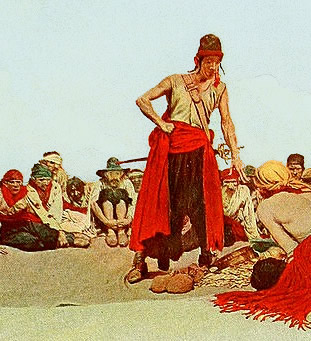
Artist: Howard Pyle - So the Treasure Was Divided (1906)
There are a couple of other points of interest worth concerning the pirate quartermaster and his role. The first concerns the quartermaster's payment. On many non-pirate ships licensed to take ships of enemy nations, the officers usually received a larger share of treasure captured during wars. This was true to some degree on pirate ships, although the payment plan was usually much flatter. (The exception being William Kidd, who received 40 shares, while the next highest payout was to the ship's master, who received 2 shares.1) Bartholomew Robert's tenth article read, "The captain and quartermaster to receive two shares of a prize: the master, boatswain, and gunner, one share and a half, and other officers one and quarter."2 Jacob du Bucquoy said that on John (Richard) Taylor's ship that "the captain, first boatswain, first master gunner and first master pilot each have a share and a quarter.... The quarter-master gets only one share, but everyone adds something for his trouble."3 While other pirate's articles mention different shares going to officers, these are the only two which specifically mention the quartermaster.
Ed Fox explains in his doctoral thesis that Richard Noland's pirates had a "‘Quarter Master to the Whole Company’, a ‘mulatto’ called Josephus was
\
An Imaginative Modern Rendering of Nathaniel North in the
World Wide
Gum
Company's Sea Raiders Trading Cards (1933)
in [charge of] the three-vessel company"4. Dr. Fox suggests that in the case where there was one quartermaster serving several ships, the common chest (the treasures collected from prey ships) would have most likely been aboard the flagship.
In a related vein, Nathaniel North was voted to be the captain's quartermaster when John Bowen was chosen as leader of a small feet in 1700, while Samuel Herault was elected quartermaster for the crew aboard the Speaker, the flagship of their small fleet.5 It is doubtful that he would have been assigned as an officer to the captain's given the flat organization structure pirates tended to prefer; it seems likely that North, like Josephus, served as a quartermaster to the fleet, although it is not certain from the description.
The pirate quartermaster's job came with a variety of responsibilities and not a little power. This was enough to tempt at least one pirate quartermaster into cheating his crew, not unlike the navy pursers who held as similar a post as the navy offered. Pirate Robert Culliford testified that when William Mays crew was sailing in the Indian Ocean in November of 1693 and, upon reaching Madagascar, "they turned out of being quartermaster [Samuel] Burgess, upon a discovery of cheating them and sayled, [from] thence"6. Of course, Madagascar was a well populated island and the natives were generally friendly to the pirates, so he didn't suffer as much as he might have.
Being one of two officers common to many pirate ship meant their role had a potential downside. Some of the pirates in Thomas Anstis' crew decided they were "tir'd with the Trade, [so they] put an End to the Reign, by shooting Tho. Anstis in his Hammock, and afterwards the Quarter-Master, and two or three others; the rest submitting, and put [them] into Irons, and surrender'd them up, and the Vessel, at Curacoa, a Dutch Settlement, where they were try'd and hang' d; and those concerned in delivering up the Vessel, acquitted."7
1 Ed Fox, "Piratical Schemes and Contracts," Thesis, 2013, p. 310; 2 Fox, p. 318; 3 "Jacob du Bucquoy describes life in the company of John Taylor", Pirates In Their Own Words, Ed Fox, ed., 2014, p. 289; 4 Ed Fox, Piratical Schemes and Contracts, Thesis, 2013, p. 176-7; 5 Daniel Defoe (Captain Charles Johnson), A General History of the Pyrates, Manuel Schonhorn, ed., 1999, p. 479 & 521; 6 Harold T. Wilkins, Captain Kidd and His Skeleton Island, 1935, p. 77; 7 Defoe (Johnson), p. 296
Golden Age Pirate Quartermaster List
An impressive number of pirate ships described in
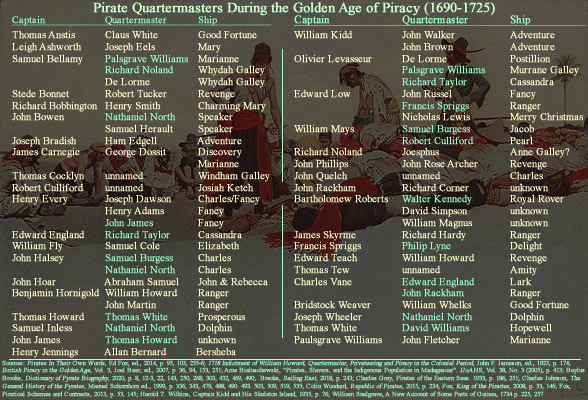
Background Image - Artist: Howard Pyle - So the Treasure Was Divided (1906)
period communications had quartermasters and many of them actually named the men who held the position. This information can be found in the image at left which gives the name of the ship's Captain, his quartermaster and the name of the ship itself, when it is known. There are 52 named quartermaster/ captain combinations and four instances of captains who had quartermasters who were not mentioned by name. Of the 52 named quartermasters, 43 are unique, while the other 10 instances are men who served as quartermaster under more than one captain and/or ship. The list includes 39 different captains.
Being one of two oft-elected officers, quartermasters were in a good position to be voted captain if the pirate captain left, died or was voted out of his office for some reason. The names of the quartermasters who eventually became captains are highlighted in green in the quartermaster column. They include 15 different men. On of them is East India pirate Nathaniel North, who served as quartermaster under no less than four different captains.1
Some captain are known to have had more than one quartermaster. In these cases, the captain's name is only included on the line containing

John Phillips, as Imagined by Some Artist, From The
History
and Lives of the Most Notorious Pirates, p. 133 (1725)
the first quartermaster who served with him with the rest of his quartermasters being organized in chronological order (where it is known.) A few captains appear to have had more than one quartermaster at the same time such as William Kidd, Bartholomew Roberts and John Bowen. They sometimes occurred when they had more than one ship in their fleet and each ship had a quartermaster or, as in the case of Bowen, there was a quartermaster for their fleet in addition to individual ship's quartermasters. (It is also possible that Bowen had a quartermaster for each vessel, but no information in the period sources was found to support this.)
Another interest point arises from this list. John Rose Archer is listed as the quartermaster of John Phillips ship, based on material found in Captain Charles Johnson's book. Johnson says, "John Rose Archer,...having been a Pyrate under the famous Black-beard, was immediately preferr'd over other People's Heads, to be Quarter-Master to the Company which sudden Promotion so disgusted some of the older Standers especially Fern, the Carpenter"2. However, in his book of collected period pirate accounts, Ed Fox points out that pressed man John Fillmore says that "the Captain, Master, Boatswain, and Quarter-master, came upon the deck, a little after eleven o'clock. Enquiry was made for [William] White and [John Rose] Archer"3. Because this passage mentions the quartermaster and Archer in the same sentence, it suggests that the quartermaster was not Archer. Johnson's book is not generally considered a primary source, although it was published during the period because it contains many unverifiable statements which may have either come from interviews with pirates waiting for trail in prison or may have been made up by the author. Still, both accounts indicate that there was a quartermaster among Phillips small crew, and, if it wasn't Archer, another unnamed man appears to have have held the office.
1 Daniel Defoe (Captain Charles Johnson), A General History of the Pyrates, Manuel Schonhorn, ed., 1999, pp. 469, 517, 519, 521 & 535; 2 Defoe (Johnson), p. 343; 3 "47. John Fillmore’s narrative", Pirates In Their Own Words, Ed Fox, 2014, p. 233

